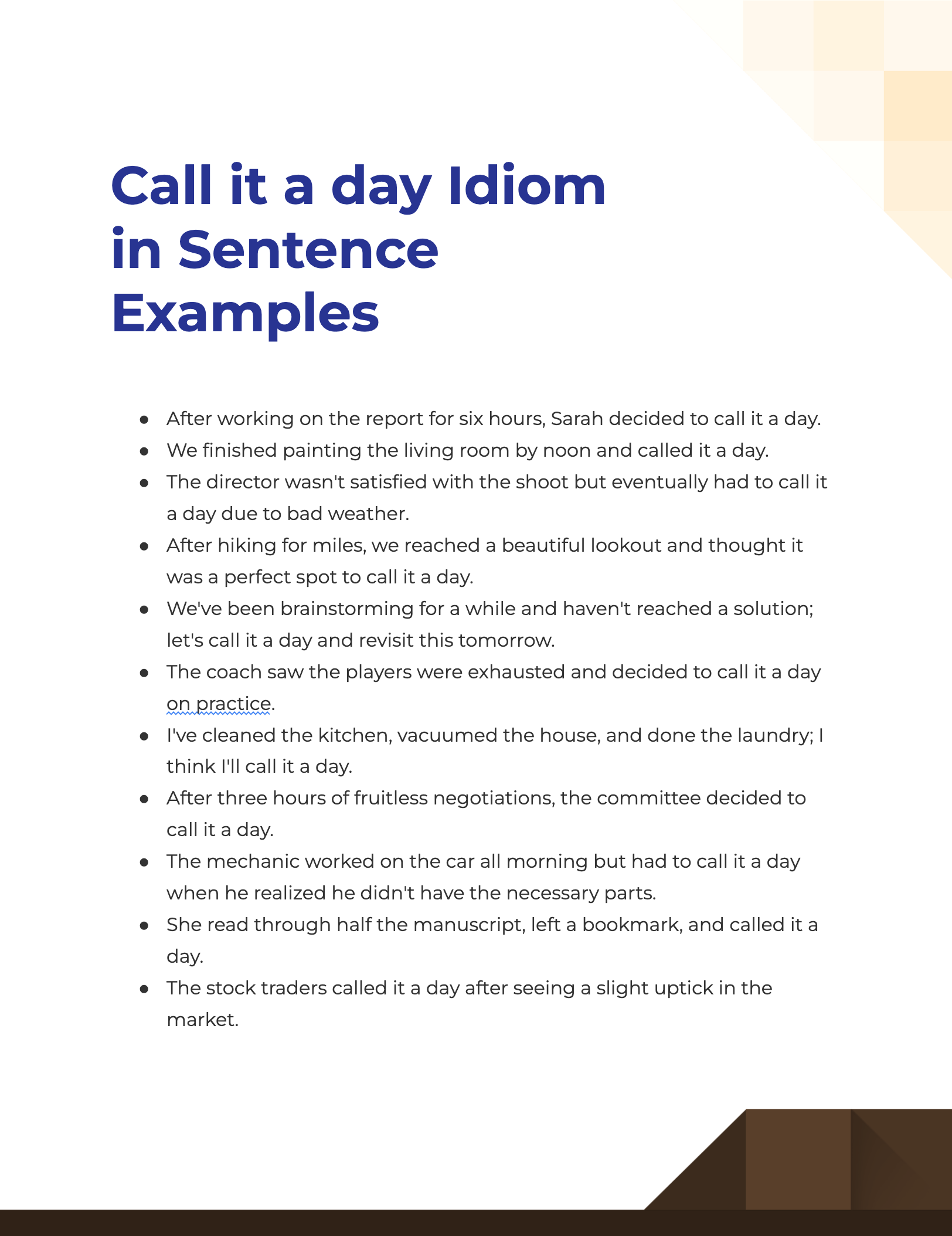19+ Call it a day Idiom Examples
Navigate the fascinating world of idioms with our insightful guide on “Call it a day.” Uncover its origin, decode its meaning, and discover how to use it seamlessly in daily conversations. Armed with real-world examples, you’ll soon be wielding this idiom like a pro. Read on to add this versatile expression to your linguistic toolkit and enrich your English vocabulary.
What is the Call it a day Idiom? – Definition
“Call it a day” is an idiom used to suggest ending an activity or task for the time being, usually because it is considered sufficient or cannot be continued at the moment.
What is the Meaning of Call it a day Idiom?
The phrase “call it a day” generally implies that you’re stopping what you’re doing because you believe it’s enough for now. It could be at the end of a workday, or it might mean stopping any activity that you consider complete or exhaustive.
Origin of Call it a day Idiom
The origin of this idiom is somewhat murky, but it’s believed to have gained popularity in the early 20th century. The phrase is thought to have roots in the industrial era when factory workers would literally “call it a day” after completing their shifts. Over time, it has evolved to encompass any activity you choose to conclude for the time being.
20 Best Sentence Examples with Call it a day Idiom

- After working on the report for six hours, Sarah decided to call it a day.
- We finished painting the living room by noon and called it a day.
- The director wasn’t satisfied with the shoot but eventually had to call it a day due to bad weather.
- After hiking for miles, we reached a beautiful lookout and thought it was a perfect spot to call it a day.
- We’ve been brainstorming for a while and haven’t reached a solution; let’s call it a day and revisit this tomorrow.
- The coach saw the players were exhausted and decided to call it a day on practice.
- I’ve cleaned the kitchen, vacuumed the house, and done the laundry; I think I’ll call it a day.
- After three hours of fruitless negotiations, the committee decided to call it a day.
- The mechanic worked on the car all morning but had to call it a day when he realized he didn’t have the necessary parts.
- She read through half the manuscript, left a bookmark, and called it a day.
- The stock traders called it a day after seeing a slight uptick in the market.
- After doing five sets of rigorous exercises, he felt it was time to call it a day at the gym.
- The baker finished decorating the last cake and knew it was time to call it a day.
- After several failed attempts to solve the equation, the students decided to call it a day.
- The band played their final encore and called it a day, exiting the stage to loud applause.
- We’ve reached our sales target for the month, so let’s call it a day and celebrate.
- After scanning through dozens of resumes without finding a suitable candidate, the HR manager decided to call it a day.
- She completed three laps around the park and then called it a day due to muscle cramps.
- After writing four chapters of his new book, the author decided it was a good point to call it a day.
- They’ve been fishing since morning without catching anything; disappointed but resigned, they decided to call it a day.
More Famous Idioms with Meaning, Sentence Examples
- Play It by Ear Idiom
- In Black and White Idiom
- Crocodile Tears Idiom
- Full of Beans Idiom
- Busy as a Bee Idiom
- Snake in the Grass Idiom
- Once in a blue moon
- Break a leg Idiom
- Beat around the bush Idiom
- Bite the bullet Idiom
- Through thick and thin Idiom
- Actions speak louder than words Idiom
- Go down in flames Idiom
- Jump on the bandwagon Idiom
- It takes two to tango Idiom
- A blessing in disguise Idiom
- Come rain or shine Idiom
- On cloud nine Idiom
- Better late than never Idiom
- Hit the sack Idiom
- Go the extra mile Idiom
- The Whole Nine Yards Idiom
- A penny for your thoughts Idiom
- Pull someone’s leg Idiom
- As right as rain Idiom
- Ignorance is bliss Idiom
- Throw caution to the wind Idiom
- Kick the bucket Idiom
- Take a rain check Idiom
How to Use Call it a Day Idiom in Sentences?
The phrase “call it a day” is commonly used in both casual and formal situations to indicate that you have decided to stop working or doing an activity, usually because you feel that you have done enough or it cannot be further continued at the moment. Below are some guidelines on how to use this idiom effectively:
- As a Conclusion: Use this idiom to wrap up a meeting, conversation, or an activity. For example, “We’ve covered all the agenda items, let’s call it a day.”
- During Activities: You can use it in the middle of activities when you decide it’s time to stop. For example, “After four hours of hiking, we decided to call it a day.”
- With Negative Outcomes: Sometimes the phrase is used when an effort turns out to be unsuccessful. For instance, “After several failed attempts to start the engine, I called it a day.”
- In the Workplace: It’s commonly used at work to signify the end of a workday or project. For example, “I submitted the quarterly report and called it a day.”
- To Suggest Rest: If someone is tired or struggling, you can use this idiom to suggest they take a break. For example, “You look exhausted. Why don’t you call it a day?”
- With Time Indicators: To emphasize the duration of activity before stopping, include time indicators. For example, “We worked on it all morning before calling it a day.”
- Sequencing: When describing a series of actions, you can use the idiom to signify the last action. For example, “I went shopping, had lunch, and then decided to call it a day.”
Tips for Using Call it a Day Idiom
- Context Matters: Although this is a commonly used idiom, make sure it fits the tone and context of your conversation. Avoid using it in extremely formal or serious discussions where a more specific phrase might be appropriate.
- Vocal Emphasis: When speaking, emphasizing the word “day” can add more weight to the statement, indicating a firm decision to stop what you’re doing.
- Be Clear: Ensure that the context makes it clear what activity or task you are referring to when saying “call it a day.”
- Combine with Gestures: When speaking, you can accompany the idiom with a gesture like closing a book, shutting down your computer, or waving goodbye to emphasize that you’re done for the day.
- Avoid Redundancy: Since the idiom itself indicates the cessation of an activity, avoid redundant phrases like, “Let’s call it a day for today.”
- Clarify if Needed: If you’re using the phrase in a new setting or with people who might not be familiar with it, you may want to clarify what you mean.
- In Writing: When using the idiom in writing, you don’t need to italicize or put quotes around it, as it is widely understood.
By adhering to these guidelines and tips, you can effectively use “call it a day” in various situations, making your communication more engaging and precise.



